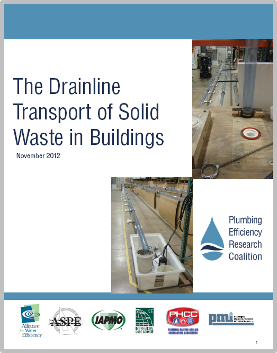The Drainline Transport of Solid Waste in Buildings

The Plumbing Efficiency Research Coalition (PERC) released The Drainline Transport of Solid Waste in Buildings report in November 2012. The study provided important insights into the performance of long buildings building drains that can be found in commercial buildings, and highlighted needs for future research. This page provides an overview and links to download the final report and associated materials.
PERC was formed in January 2009 through a Memorandum of Understanding (MOU) to develop research projects that support the development of water efficiency and sustainable plumbing products, systems and practices. Projects are financed through government grants, foundations and private financing. The Coalition is comprised of industry organizations seeking to conduct much-needed research in a number of areas. PERC identified drainline transport as its first research project.
In January 2011, PERC signed a MOU with the Australasian Scientific Review of Reduction of Flows on Plumbing and Drainage Systems Committee (ASFlow) at the offices of the U.S. Environmental Protection Agency (EPA). The MOU details several areas of collaboration between the groups to ensure that research efforts are not duplicated and that information and results are shared. ASFlow has also studied the impact of reduced water flow in sanitary drainage systems.
After the parameters of the project were defined, the coalition began seeking funding. Many funders stepped up to the plate and are listed at the bottom of the page. American Standard generously provided space and a drainline testing apparatus at its Product Development Design Center in Piscataway, New Jersey. The test procedure consisted of 40 test runs with each run consisting of 100 flushes from a surge injector. The surge injector was used to provide the required flush volume 0.8, 1.28, or 1.6 gallons (3.0, 4.8, or 6.0 liters ), flush rate, and percent trailing water.
Project Outcomes
The results of the study demonstrate how changes in variables such as flush volume, toilet paper, and pipe slope impact drainline function. Due to the uncertainty surrounding the use of high-efficiency toilets (HETs) in nonresidential buildings, many municipalities were hesitant to move forward with programs that would replace inefficient toilets with HETs for the commercial sector. Organizations like AWE could not recommend the use of HETs in commercial buildings with confidence, and WaterSense® did not pursue a specification for commercial HETs. Based on the findings of the study, the PERC Technical Committee recommended that WaterSense® should, “expand their specification on toilets to include commercial flushometer-valve operated HETs.”
Key findings:
- Percent trailing water and flush rate were found to be non-significant variables.
- The 5 gallon clearing flush failed to clear drainlines in 7 of 39 test runs and is not a recommended low cost solution at the frequency levels used in the study.
- Pipe slope was identified as a significant variable impacting drainline carry.
- Toilet paper was identified as an important variable, specifically the wet tensile strength.
- Flush volume was identified as a significant variable.
- 0.8gpf (3.0 Lpf) flush volumes were evaluated and the results indicate that they may be, “problematic in commercial installations that have long horizontal drains and little or no additional long duration flows available to assist the toilet in providing drainline transport of solids.”
- The results identified a possible inverse effect of the slope test variable at the 0.8 gallon (3.0 L) test run level.





